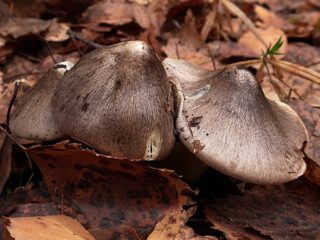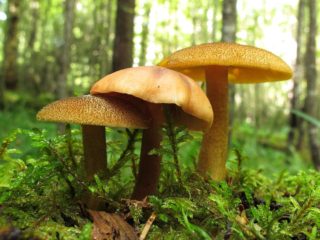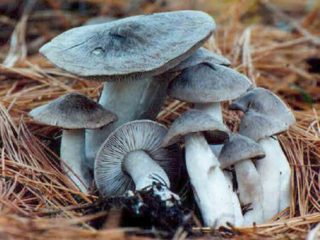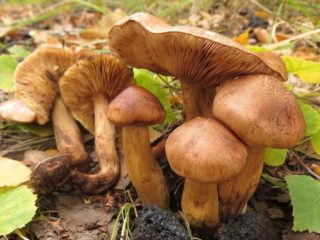Content
The mushroom, known as matsutake, is a member of the Ryadovkov family. It is considered a delicacy, most valued in eastern countries, and is often used in the preparation of Asian dishes. A photo and description of the shod row will help distinguish it from other members of the family. The mushroom has a bright taste, as well as beneficial properties.
What does a shod row look like (matsutake)
Shod row or tricholoma caligatum, has a wide cap, the diameter of which can reach 20 cm.The shade can vary from light brown to dark brown, or resin. Mature specimens have cracks located around the cap. This allows you to examine the soft body of the mushroom. There are many scales on the surface of the cap. The scales themselves are dark brown.
The thickness of the leg is on average 2.5-3 cm, and its length can reach 20-25 cm. At the base the leg is widest. It has a brown tint, a sharp downward slope, and is located near the ground. She also has a brown ring on her.
The lamellar body of the shod row is light in color; there is a small depression on the plates themselves. In young specimens, the lamellar body is hidden under a protective film, so it is not noticeable. As the mushroom grows, the film transforms into a ring at the bottom of the stem; its distinctive feature is the presence of a fringe.
In the row mushroom, the shod flesh on the stem has a white tint, the texture is elastic and dense. The spores are small in size and round in shape.
Where does the shod row grow in Russia?
Ryadovka shod or matsutake grows in countries such as Japan, China, Korea, Sweden, and Russia. Found in areas where sandy soil covered with moss predominates. Most often - in pine forests and coniferous forests. Sometimes rowing is found in parks and gardens.
This mushroom is considered quite rare; in almost all regions of the country it is included in the regional red books. The row can be found on the Kola Peninsula of the Murmansk region. Shod row is sometimes found in the Leningrad region and grows in forests. The most optimal time for collection is considered to be autumn, mainly the month of October.
Some varieties are also found in other areas.The gray shoeed rower is found in the Moscow region in coniferous and mixed forests. It can be found from August until the first frost.
The shod row is most often found in the Urals. Mainly in the Irkutsk and Amur regions, as well as in the Khabarovsk Territory.
How to find a shod row
This type of mushroom is distinguished by the fact that it grows quite deep. In some cases, the row has to be dug up, since its leg is located far in the ground. It is quite difficult to detect it with the naked eye. The mushroom picker has to carefully peer into the ground, since more often the row is camouflaged under fallen leaves or under moss.
Mostly matsutake hides under white moss, but is sometimes found under coniferous trees or oaks. The mushroom is located at the very foot of the tree, and it grows only in oak trees that are at least 70 years old. The row grows around the tree trunk, forming a ring shape.
It is necessary to search in infertile soil. When the leaves fall, the soil becomes most fertile, and in such conditions the fungus stops reproducing. This explains that the row does not bear fruit in the same place for more than 8 years.
Matsutake grows only under certain climatic conditions. It can only be found in areas where the daytime temperature does not exceed 26°C, while at night the temperature does not drop below 15°C. It grows most readily during periods of heavy rainfall.
Additional information about mushroom picking in this video:
Is it possible to eat spotted rower?
Spotted row is considered an edible mushroom.In Asian countries, special attention is paid to the row, as it is considered a delicacy and is used to prepare many dishes.
Attention! Among the rows there are also poisonous specimens; their characteristic feature is a sharp unpleasant odor, which intensifies when broken.
In order not to cut off a poisonous mushroom, when collecting, you should take into account the characteristic features related to edible specimens:
- thick layer of pulp;
- small cracks on the edges;
- slightly convex hat;
- the leg has a cylindrical shape;
- there are records;
- the smell is weak.
Poisonous and edible mushrooms differ not only in smell, but also in appearance. Edible matsutake has a white flesh that is firm and not watery. The leg is long, dark brown. It is difficult to remove from the soil.
Taste qualities of mushroom
Ryadovka has a bright taste; its taste is slightly reminiscent of pear and pine needles. Their taste goes well with potatoes and fried onions. They are often added to various salads, combined with rice, bell pepper, mayonnaise, garlic and paprika. All possible methods are used for cooking; mushrooms can be pickled, salted, stewed, fried and boiled.
The taste is slightly bitter, the smell resembles the aroma of anise.
Benefits and harm to the body
Matsutake has antiviral, antioxidant, anti-inflammatory and antibacterial properties. In addition, consumption of the mushroom helps to increase the protective properties of the body, since it contains a large number of useful substances presented in the table.
Minerals and vitamins | Amino acids |
· phosphorus; · potassium; · manganese; · selenium; · zinc; · iron; · sodium; · copper; · vitamins B, C, A, PP, K, D. | · alanine; · lysine; · threonine; · glutamic acid; · stearic acid; · phenylanine. |
Regular consumption of ryowka helps improve the functioning of the heart and blood vessels, normalize blood sugar levels and stabilize blood pressure. It also helps reduce nervous tension, improves performance and relieves fatigue. Removes toxins, improves the functioning of the gastrointestinal tract and liver.
False doubles
Poisonous counterparts of matsutake are quite rare. A poisonous mushroom is easy to distinguish from an edible one, as it has bright features. The poisonous gray row is distinguished by its appearance, since its flesh has a dull gray color, the texture is uneven and slimy. Its use causes severe gastrointestinal disturbances.
White poisonous row, despite its name, does not have a white tint. Its color is inconspicuous, gray-white. Juveniles have virtually no odor. However, when they break, a sharp and unpleasant odor appears. False specimens have a different color of hat, it resembles the color of a leopard and has a large number of spots.
The type of inedible row is shown in the photo.
Collection rules
It is recommended to collect rows of mushrooms in the autumn, and the largest number of mushrooms can be observed during the first cold weather. The exact collection period depends on the specific area: in some regions, matsutake can be found as early as August. But it is best to go to the forest in the first autumn months, when the leaves begin to fall.
When collecting matsutake, you should not pull out the mushroom; it is carefully cut off with a knife so as not to damage the entire mycelium.Rowing is sought in open areas, especially in areas where a large amount of moss grows. It is also found at the base of trees. A distinctive feature is that several mushrooms form a whole row.
Use
Matsutake mushrooms are subjected to heat treatment, they are also pickled and salted. Raw consumption is contraindicated. It is not recommended to eat old mushrooms, as they have the ability to accumulate anthropogenic pollution. If you eat too much and too often, gastrointestinal disturbances may occur.
These mushrooms are used not only in cooking, but also in cosmetology and medicine. Some antibiotics, drugs for diabetics, as well as medications for the treatment of cancer are produced on their basis. Matsutake is also used to treat skin diseases: used as lotions.
How to grow a booted row
Growing shod rows is a rather complex process. The algorithm is similar to growing champignons. The crop is planted in May; dry straw and horse manure or bird droppings can be used as soil. They can be grown in garden beds or at home. A prerequisite is compliance with the temperature regime - the air temperature should not fall below 15°C.
After planting, it is very important to create high humidity. You need to add soil, the average thickness of which is 5 cm. For successful cultivation there must be a sufficient level of light, as well as fresh air.
If you want to grow matsutake yourself, take into account all the requirements. Growing conditions must be suitable.It is best to use a summer cottage for these purposes, since at home these mushrooms do not have enough light and air, which leads to their death.
Conclusion
Matsutake is a rare mushroom; to find it, you need to make a lot of effort, which will be helped by the photo and description of the shod row. When collecting, pay attention to their appearance and smell, since sometimes you can find a poisonous double, which at first glance looks like an edible mushroom.













